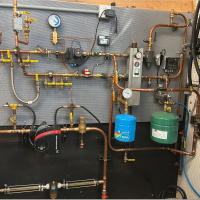Minimum boiler temp for Burnham SCG HW boiler
I have a c2007 Burnham SCG hot water boiler, controlled by a Taco SR504-EXP switching relay and a PC700-2 reset control. The boiler is a late generation, 85% + AFUEboiler with a cast-iron heat exchanger. My understanding is that it is not intended to operate as condensing, but there is a condensate line in the horizontal section of the exhaust stack and a condensate pump does exist. I have never heard the pump run, but have tested it and know it works.
My question is what the Boiler Minimum supply temp should be for this type of boiler to protect the HX. A tech pulled the PC700-2 out of the controls, Amit does in fact work and I want to put it back in service.
Thanks in advance?
Comments
-
140* will prevent any sustained condensation. There will always be some condensation with a cold start, but that should quickly be burned off.
A boiler bypass or thermostatic valve can offer further protection.
Bob Boan
You can choose to do what you want, but you cannot choose the consequences.0 -
all boilers are condensing boilers when they cold start
Within 10 minutes you want the return above 130
Then, ideally a 10- 20 minute burner on time to dry out the flue assembly
Bob "hot rod" Rohr
trainer for Caleffi NA
Living the hydronic dream0 -
After reading the I/O manual for that boiler, there does not seem to be a recommended minimum temperature, however the manufacturer does reference installing a bypass in order to raise the return temperature. The only reason that a boiler manufacturer might have such a recommendation is to reduce flue gas condensation. There is a recommendation to design the system for a 20° ∆T. The industry standard is 140° for return water after the boiler reaches steady state operation (usually within the first 5 minutes). If you can not get the return temperature to reach 140° within that time, you can adjust the valves on the bypass and the supply in order to get the required return water temperature.
Other manufacturers of cast iron boilers have lower minimum return water temperature recommendations. Absent those specifications on this boiler I would err on the side of caution and adjust for 160° on the supply and 140° on the return within 5 minutes of operation.
Edward Young Retired
After you make that expensive repair and you still have the same problem, What will you check next?
0 -
Thanks for the quick feedback guys. This is my first time posting, love that I got three responses the first day.
This system is not piped with a bypass, I’ll need to plan accordingly with my supply set point.
0 -
i think the condensate drain is for any gases that condense in the powered vent, it is not meant to have any condensation in the boiler. if you need a bypass or not depends on what type of system it is connected to.
If you want to run aggressive odr, it is connected to a high mass system or it is connected to a radiant system you will need return water temp protection. I would use a thermostatic valve for the protection.
0 -
you’re right about the condensate drain. Assuming the system does in fact run a 20 degree delta T, I’ll need a 145-150 supply temp min. Not much reset I guess.
I assume the system is considered low mass, it’s fin tube.
0 -
With copper pipe with aluminum fin baseboard, you will not need a bypass. The boiler temperature will get to 160° in a fairly short time (like 4 to 6 minutes) making the return water 140° at about the same time. As long as the burner run cycles are at least 5 more minutes (total of 10 minutes), or the burner shuts of by the high limit set at about 170° to 200°, you will not have any issues with condensation of flue gas on that boiler.
Edward Young Retired
After you make that expensive repair and you still have the same problem, What will you check next?
0 -
unless they want to use the odr control.
0 -
If you use ODR you need to set a min. with CI boilers.
The dewpoint is not an exact number. It varies based on the fuel and the % of CO2, which you could read on a combustion analyzer, adjust the burner to the ideal range.
The 20∆ is just a random number used to design around, yours and many systems may never run an exact 20∆.
The heat emitters ALWAYS dictate the operating condition of the boiler or heat source. Unless you put a control to constrain, or force (not always a good idea) a system to run at a specific condition. Like a ∆T circulator.
Bob "hot rod" Rohr
trainer for Caleffi NA
Living the hydronic dream1
Categories
- All Categories
- 87.3K THE MAIN WALL
- 3.2K A-C, Heat Pumps & Refrigeration
- 61 Biomass
- 429 Carbon Monoxide Awareness
- 120 Chimneys & Flues
- 2.1K Domestic Hot Water
- 5.8K Gas Heating
- 115 Geothermal
- 166 Indoor-Air Quality
- 3.7K Oil Heating
- 77 Pipe Deterioration
- 1K Plumbing
- 6.5K Radiant Heating
- 395 Solar
- 15.7K Strictly Steam
- 3.4K Thermostats and Controls
- 56 Water Quality
- 51 Industry Classes
- 50 Job Opportunities
- 18 Recall Announcements



